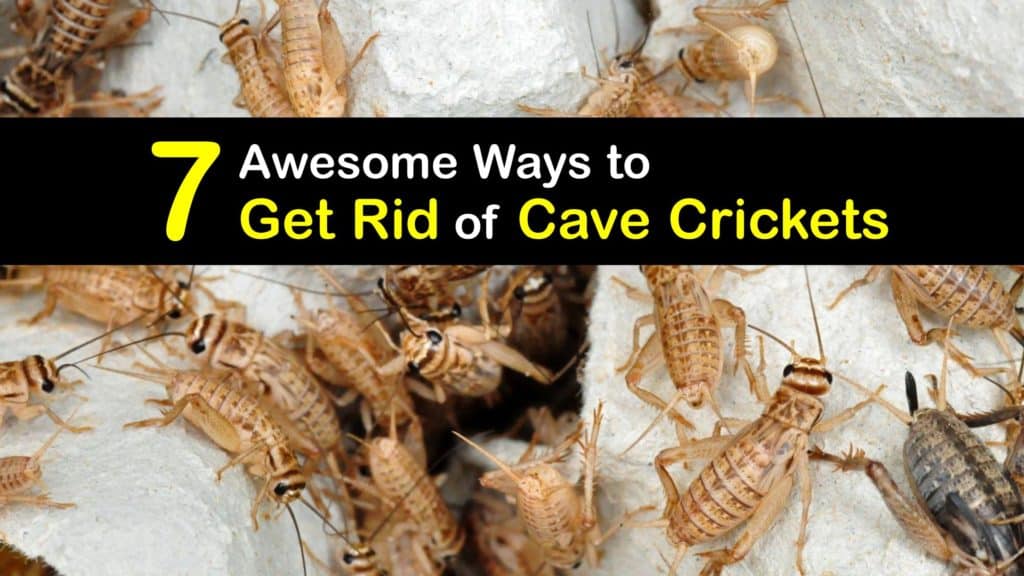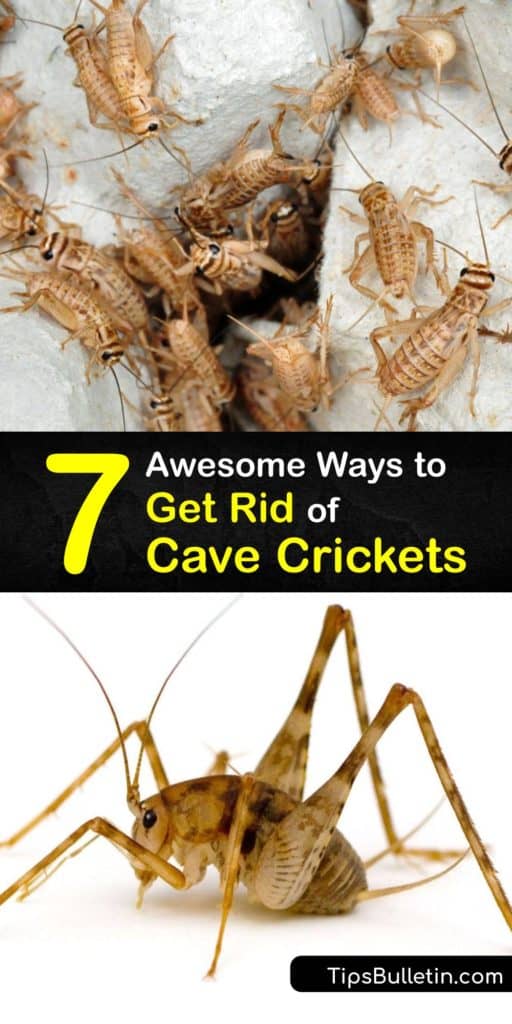Cricket chirps in the tall grass have a special place in the pop culture of North America. However, crickets are significantly less charming when the chirps come from inside your home. Discover how to get rid of cave crickets with these clever solutions, so you can kick back and enjoy the summer worry-free.
Of some nine hundred cricket species, the usual suspects are house crickets, mole crickets, field crickets, and cave crickets, also known as camel cricket, camelback cricket, or spider cricket. Each species looks slightly different, but generally, they’re up to two inches long, range in color from yellow to dark brown, and have distinctive long antennae.
The house cricket and field cricket are the varieties most likely to be found freeloading inside your home, but it’s not uncommon to run across mole crickets as well. While they’re not considered destructive pests, crickets munch your fabric and furniture, and cricket waste can also contain bacteria.

What is the Best Way to Get Rid of Cave Crickets?
Give crickets the boot before they settle in for the winter. Learn about spider cricket control tips and the best way to get rid of cave crickets, and some natural ways to get rid of crickets, too.
Dish Soap for Pest Control
If you spot the tell-tale dirt mounds of mole crickets or a cricket infestation outside, try something simple that gets rid of cricket spiders before calling the pest control service.
One of the quickest home remedies for getting rid of cave crickets and most other crickets involves some soapy water and some initiative. Use this easy mixture as the best way to get rid of crickets in outdoor spaces you suspect may house crickets or nests.

Get your hot, soapy water mixed and head outside. The raised dirt mounds of the mole cricket are pretty easy to spot; pour the soapy liquid in and around the mound, and continue to soak daily until the cricket activity recedes.
Dish soap won’t do serious stuff like cockroach control, but it will give you a leg up on any mole cricket, field cricket, or spider cricket trying to take over your yard.
Exterior Insecticide for a Cricket Infestation
Crickets aren’t entirely unhelpful; they’re beneficial for gardeners and break down plant debris into helpful soil fuel. However, the cricket’s place is in the food chain, not intruding on your home. In some areas like New Jersey, where the field cricket is a serious pest, you may need to turn to exterior insecticides.
Complete a bit of preventative maintenance before applying any insecticide around your door frames, garage doors, and basement windows. Replace worn sealing, and fill gaps or cracks that provide a way inside. The average field cricket can jump up to three feet, which means securing your exterior vents and crevices is essential.
The best way to get rid of cave crickets is to keep them from coming in. For areas outside, create a barrier to your home by applying the least toxic option to solve the problem.
Interior Insecticide for Pests
Temperature changes can push the cricket population toward your door, and a camel cricket infestation isn’t uncommon in some regions of North America. It’s great to have some tips for how to get rid of cave crickets because they love a damp basement, crawl space, or wood piles.
A true cricket is nocturnal; wait until nightfall for chirping noises if you’re suspicious. If you spot a cave cricket indoors, it’s time to act. Check every damp area and look for eggs behind warm appliances and in closets where they can feast on silk, cotton, and other fabrics.
There are plenty of indoor insecticides for use along baseboards and window frames, and you can choose between sprays, powders, or granules. The best way to kill camel crickets or another variety is whatever works best for you and your family.
Fight Cave Crickets with Boric Acid
You may be curious about how to get rid of cave crickets with boric acid; it’s straightforward. Boric acid comes from a naturally occurring mineral called boron, and it is a popular and effective pesticide against regular crickets.
Boric acid works against crickets and cockroaches but does not guarantee tick control or effect on any bed bug variety. It’s available in almost any form; powder, tablet, liquid, and even a pesticide paste. Follow the easy-to-use manufacturer’s directions for each specific product to kill spider crickets inside or out.
Natural Ways to Get Rid of Cave Crickets
There must be some more natural ways to kill cave crickets. If you’re keen to avoid dangerous chemicals that are toxic to your family and the environment, or the inhumane nature of a sticky trap or glue trap, we’ve got some other options.
Have you heard of diatomaceous earth? It’s a mineral powder you spread along baseboards and window sills or behind the stove and cabinets. It dries the exoskeletons of hard-bodied bugs and kills them and is great to get rid of camel crickets, ants, spiders, and roaches. The mammalian toxicity level is extremely low, but prolonged, close exposure may irritate the skin.
Try Biopesticides for Crickets
What are biopesticides, and do they count as one of the natural ways to get rid of cave crickets? Biopesticides fall into the “natural approach” category, whether you want to get rid of mole crickets, cave crickets or another annoying bug.
To be classified as a biopesticide, they must pose a low risk to the environment and people. Biopesticides usually come from plants, mineral oils, and mineral salts. They target a specific pest versus a broad-spectrum, no insect life at all approach.
The best way to get rid of cave crickets may include several strategies. Many everyday items are considered possible biopesticides, including vinegar, table salt, and plant oils.
For example, horticultural oil is a safe, effective pesticide when applied to indoor problem areas. Try capsaicin or chili powder to deter crickets in doorways, or plant alliums like onions, garlic, and chives to repel garden invaders and attract pollinators.
How to Get Rid of Cave Crickets with Molasses
Because it makes an excellent indoor cricket bait, molasses and water might technically count as a biopesticide. If you have an indoor infestation or a greenhouse camel cricket problem, this simple molasses bait traps crickets without fail.
Choose a large bowl and fill it halfway with water, then stir in the molasses. Leave a bowl where you suspect cricket activity. They smell the sweet mixture, jump into the water and die. Use this natural trapping and disposal method to lure out any otherwise hard-to-find pests, and you may be surprised.
Crickets provide nutrition for many birds and mammals, and eradicating them has apparent consequences for the food chain. It’s always a challenge to strike an appropriate balance between firm pest control and what benefits the delicate biological environment around us. Fortunately, there are several alternatives for conscientious gardeners and homeowners.
Now that you know how to get rid of cave crickets and other pests, you can make informed decisions about future pest management. Use chemical products sparingly and as a last resort; always choose the least toxic option. Employ moisture management strategies and good garden planning; counter pests before they come calling.

If you feel motivated by learning how to get rid of cave crickets in creative, natural ways, then share these tips with a friend on Pinterest or Facebook who could do with some critical cricket info.